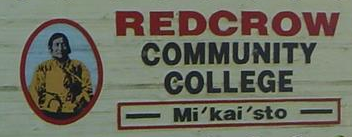Ninaika’ksimii – Artemisia ludoviciana Nutt. (Man Sage; Prairie Sage)
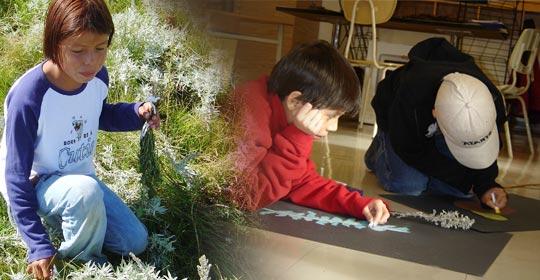
Kendra picking Louisiana Sagewort in the dry prairie. Noah and Shelby drawing Louisiana Sagewort.
Learn about the different kinds of Sage.
Ninaika’ksimii
Nitsitapi niitainihkatoomiaw ninaika’ksimii. Iitaohkooni’p saokioohtsi ki otsitskitsahkohpi. Elder Carolla Calf Robe annikki iikitowakaisaisskiiyaw apatohsoohtsi noom Kainai. Ninaika’ksimii iitowapisstsiskitsi mo Pakkii’pistsiotsitai’tspi ki Mo’kaato’si. Anikki nahk Carolla iikitsoka’pi mo aksiksistoksahki Iisamsootamstaa ki mo Niipomahkatoyiiksistsikomiaato’si ahkitsiiko’tsi’saa, ihtanistsii annik matatsitaisoka’piiwaistsa.
Ihkitsikioomianistsi ka’ksimii ihtayissitapiiyo’pistsi. Ihkanayoohkiitsi niitohtayissitapiiyo’pia. Mamio’kakiikin(Adam Delaney) nitaanikkinaan niitaoni’p ninaika’ksimii ki aakiika’ksimii. Ihtaoni’pia otanistsinattsipia ki otanistaipisspssaiskihpia. Ninaika’ksimii aotsitsksipispssaiskii ki aakiika’ksimii matanitaipisspssaiskii. Ninaika’ksimii iikitapssoka’pi akitaisstsiyo’p ki i’kamaisstsohksistonioki. Iikakaomianistohtayissitapiyo’p ninaika’ksimii. Elder Carolla Calf Robe anikki iikohtaikskamio’p i’kamohtssimioki. Adam anikki ohkiiyoohtohkohsin iikitapssoka’pi. Elder Carolla Calf Robe anikki iikaitsiyiimo ka’ksimii ki iikatowa’pi’nsimaan akitoh tayisitapiiyo’p i’kamohtamato’simo’ki. Ponokaomitaiksi matohtaotoitsikataayaw.
Louisiana Sagewort
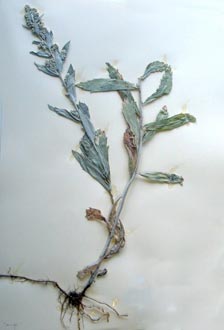
Artemisia ludoviciana Nutt.
Galileo Educational Network
Our people call Louisiana Sage Wort – Man Sage. You will find a lot of it, on the prairie and on dry open soils. Elder Carolla Calf Robe told us that it grows a lot on the north end of the reserve. It grows from 30 cm to a meter tall with a hairy stem. The leaves have pointed tips and are hairy too. The entire plant is silvery green. You have to look really closely to see the yellowish flowers with white hairs. Man Sage flowers in August and early September. Carolla told us that the best time to pick it is in late June and July because after that you get too many seeds and the leaves are not as thick.
There are seven different kinds of sage that we use. We have a different use for each kind of sage. Elder Adam Delaney told us that you could tell Man Sage and Woman Sage apart by looking for that silver colour. Woman Sage is a much lighter colour. Man Sage grows taller than Woman Sage. Woman Sage has tiny kernels at the top, which are the seeds.
The leaves of the Man Sage have good medicine for our bodies and for our spirit. If you chew the leaves during a sweat, it helps relieve sore lungs. Elder Adam Delany told us that if you hold the leaves in front of your nose and mouth during a sweat it helps you breath in the hot air. He said the sage has a kind of menthol action. In a sweat, hold the sage on the sore part of your body and it will feel better. Wait for the elder in the sweat to tell you when to put it on the sore part.
Instead of taking an aspirin, our elders might have taken dried sage and put it on hot rocks and breathed in the smudge to sooth a headache.
You can also drink a tea of the leaves to help loosen up a heavy chest or a sore throat. The tea helps to clean your liver and get rid of toxins in your body. Drinking it helps settle a sore stomach. Skin swellings on your face or hemorrhoids can be soothed with a wash of the tea. Elder Carolla Calf Robe told us that sage tea is like an energizer. She told us that is better than taking a vitamin pill because it has many vitamins and minerals in it. Adam Delaney told us that the tea is excellent for arthritis. Make sure you add the roots of the plant with the leaves. If you drink it everyday for a month, you should start to feel better. You can make a mush of the leaves for blisters and to burst boils. That same mush helps heal sprains or broken bones. Elder Carolla Calf Robe showed us how you soften the leaves in your mouth and then apply it on your skin as a bandage. This kind of bandage stops the bleeding and quickly heals the cut.
The leaves are very fragrant. They can be used to pack things away for storage. Bugs don’t like the smell of sage so if you packed your things with sage, they might stay away. Our elders are said to have put sage in moccasins for sweet smelling feet. They stuffed saddles and pillows with it as well.
In the old days, Man Sage, like Woman Sage, was used as toilet paper, for diapers and for menstrual pads. Today it is still used to make mats in sweat lodges.
Our elders treated sick horses with a sage tea, too. They would give it to their horses for coughing, sneezing and to clean the horses’ sinuses. They would smudge the horse so that mucous would dry up. Adam Delany told us that in the old days, he made a strong tea of the sage with a bit of liniment for his racehorse and he would put it on the horses’ legs. This worked much better than just straight liniment in soothing sore muscles.
Sage is a holy plant and it is used as an offering during prayer. It is also used to cleanse our spirit. If you make a smudge of it, the smoke helps to take away the negative parts of our thoughts and actions. It helps bring you closer to the Creator and your pure self.
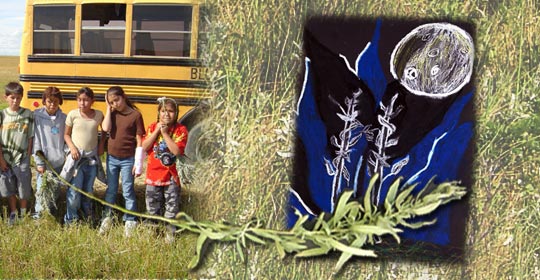
Kainai kids pose for the camera after picking Louisiana Sagewort in its natural environment. Fresh Sagewort in the foreground and a pastel drawing in the background.
Armoise de Louisiane
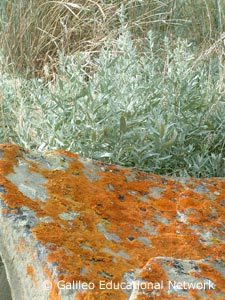
Artemisia ludoviciana Nutt.
Galileo Educational Network
Notre peuple appelle l’armoise de Louisiane l’armoise de l’homme. Nous en trouvons de grandes quantités dans les prairies et dans les sols secs et clairs. L’aînée Carolla Calf Robe nous a dit qu’il en pousse beaucoup du côté nord de la réserve. Cette plante mesure de 30 centimètres à 1 mètre de haut. Sa tige est velue. Les feuilles sont pointues en plus d’être velues. Toute la plante est d’un vert argenté. Il faut regarder de près pour voir les fleurs jaunâtres revêtues de poils blancs. L’armoise de Louisiane fleurit en août et au début septembre. Selon Carolla, le meilleur temps pour cueillir cette plante, c’est de la fin juin au mois de juillet, parce qu’après cela, il y a trop de graines et les feuilles ne sont pas aussi épaisses.
Nous nous servons de sept sortes d’armoise différentes. Chaque type d’armoise a des usages différents. L’aîné Adam Delaney nous a dit que nous pouvions différencier l’armoise de l’homme de l’armoise de la femme en recherchant cette couleur argentée. La couleur de l’armoise de la femme est beaucoup plus claire. L’armoise de l’homme est plus haute que l’armoise de la femme. Aussi, l’armoise de la femme a de petites graines au sommet.
Les feuilles de l’armoise de l’homme sont de bons remèdes pour le corps et l’esprit. Si nous mâchons ces feuilles pendant l’exsudation, elles soulagent nos poumons endoloris. L’aîné Adam Delaney nous a dit que si nous tenons ces feuilles en face de notre nez et de notre bouche, elles nous aident à inspirer l’air chaud. Il nous a aussi dit que l’armoise agit un peu comme du menthol. Pendant l’exsudation, il nous suffit de tenir l’armoise sur la partie endolorie de notre corps pour nous sentir mieux. Il faut par contre attendre que l’aîné nous dise à quel moment le faire.
Au lieu de prendre de l’aspirine, nos aînés pouvaient prendre de l’armoise séchée, la plaçaient sur des roches chauffées et l’inspiraient pour guérir leurs maux de tête.
Nous pouvons aussi boire du thé fait à partir des feuilles de cette plante pour nous dégager la poitrine ou calmer nos maux de gorge. Ce thé nous aide à nettoyer notre foi et à nous débarrasser des toxines se trouvant dans notre corps. Boire ce thé nous aide à soulager les troubles d’estomac. Aussi, les enflures au visage ou les hémorroïdes peuvent être apaisées après avoir été frictionnées avec ce thé. L’aînée Carolla Calf Robe nous a dit que le thé d’armoise est énergisant. Elle nous a dit que ce thé était meilleur que des comprimés de vitamines parce qu’il contient de grandes quantités de vitamines et de minéraux. Aussi, l’aîné Adam Delaney nous a dit que ce thé est excellent pour traiter l’arthrite. Quand nous faisons ce thé, nous ne devons pas oublier de mélanger les racines de cette plante à ses feuilles. Si nous buvons ce thé tous les jours pendant un mois, nous commencerons à nous sentir mieux. Nous pouvons aussi faire une bouillie à partir des feuilles de cette plante pour guérir les ampoules et faire éclater les clous ou furoncles. Cette même bouillie peut aussi aider à guérir les entorses ou les os cassés. L’aînée Carolla Calf Robe nous a montré comment amollir les feuilles dans notre bouche et ensuite, les appliquer sur notre peau comme s’il s’agissait de pansements. Ce genre de pansement arrête les saignements et guérit les coupures rapidement.
Les feuilles de cette plante sont parfumées. Nous pouvons nous en servir quand nous entreposons des objets. Les insectes n’aiment pas l’odeur de l’armoise, ce qui veut dire qu’ils ont tendance à s’éloigner des objets entreposés. L’aînée Carolla Calf Robe nous a montré comment frotter cette plante sur notre peau afin d’éloigner les insectes. La bouillie d’armoise a pour effet d’éloigner les insectes. Nos aînés ont dit qu’ils mettaient de l’armoise dans leurs mocassins pour que leurs pieds sentent bon. Ils en mettaient aussi dans les oreillers et les selles de chevaux. Anciennement, l’armoise de l’homme et l’armoise de la femme servaient de papier de toilette, de couches ou de serviettes hygiéniques. De nos jours, nous nous en servons encore pour faire des tapis pour les tipis d’exsudation.
Nos aînés traitaient leurs chevaux malades avec du thé d’armoise. Ils donnaient ce thé à leurs chevaux s’ils toussaient ou éternuaient, ou encore pour dégager leurs sinus. Ce thé permettait aussi de faire sécher la muqueuse des chevaux. L’aîné Adam Delaney nous a dit qu’anciennement, il faisait un thé d’armoise fort avec un peu de liniment pour mettre sur les pattes de son cheval de course. Ce mélange donnait de bien meilleurs résultats qu’un simple liniment quand venait le temps de soulager les muscles endoloris.
L’armoise est une plante sacrée. Nous nous en servons en guise d’offrande pendant nos prières. Elle sert aussi à nous nettoyer l’esprit. Si nous en faisons une bouillie, la fumée aide à chasser les aspects négatifs de nos pensées et nos gestes. Elle nous aide à nous rapprocher de notre Créateur et de notre propre pureté.
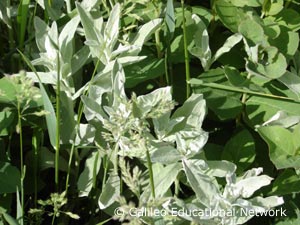
Artemisia ludoviciana Nutt.
Carolla Calf Robe
- Glenbow Museum. (2005). Nitsitapiisinni Exhibit Calgary, Alberta: Blackfoot Gallery Committee.
- Calf Robe, C. (personal communication February 1, 2005)referred to Man Sage.
- Delaney, A. (personal communication November 12, 2004)referred to Man Sage.
- Hellson, John C. (1974). Ethnobotany of the Blackfoot Indians. Ottawa: National Museums of Canada.
Kerik, Joan. (1979). Living With The Land: Use of Plants by the Native People Of Alberta. Edmonton, Alberta: Provincial Museum of Alberta.



